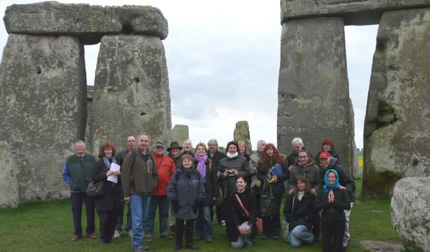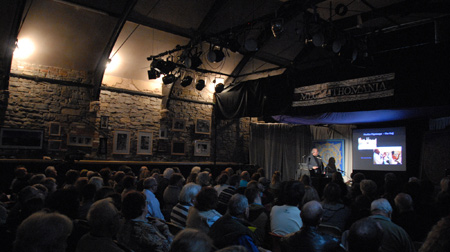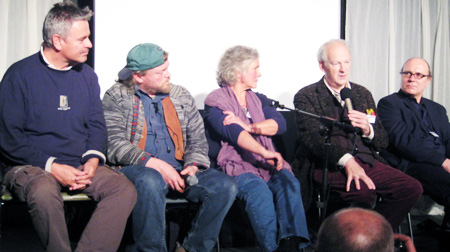Megalithomania 2010 Glastonbury Conference review by Maia of Shaldon
Hugh Newman and his team have every reason to be as high as kites on Windmill Hill. Megalithomania 2010 in Glastonbury was the weekend of wonder, weird and self confessed crazy, and in so many ways was the best yet. The sound and visuals were top notch and the artwork surrounded us with mandala delight. There was an emphasis on ‘sound’ and ‘time’ – many speakers wanted us to think again about our commonly held ideas and blow them out the door marked 101. So what did we all talk about?

The Conference began for me with the tour of Stonehenge and Woodhenge, places I know well, but I had my first experience of being there with Maria Wheatley. What a woman! Her commitment to continuing the work of her Father Dennis, Hamish Miller and other esteemed Antiquarians was a joy to see. She swept us along her knowledge path like a tsunami – until Brian (“I will have to handcuff you” – “promises” I said) the Security Man stopped her flow for a roll call. Her power moved towards anti-establishment, and I for one would ask her to be my advocate in any setting! After that, the silent time suggested by Astro John was a magical moment for me, being the only quiet moment of ecstasy for me in Stonehenge since 1969 …. but that is another story. I joined her again for a tour of Avebury. We dowsed for lost sites, had secrets revealed to us with the competent assistance of Busty Taylor, and I can truly say that both these were excellent tours with knowledgeable and exciting leaders.
Back in Glastonbury Assembly Rooms, Saturday began with Gary Biltcliffe and the Belinus Line. He has studied this ley line at ground level, and his well timed talk took us ably through the tip of his research iceberg. He gave us a convincing explanation to the naming and placing of many major locations in Britain . Paul Devereux’s lithophonic research led us to a few a-ha moments. Several speakers over the weekend had linked into this idea, and we saw the evidence for ringing stones all over the world from Palaeolithic age onwards. Paul showed us that ancient man ‘had ears as well as eyes’, and that archeoacoustics were sensitive to place and time (i.e date/ day/ temperature), and are present in very sophisticated built environments. He told us that the Stonehenge blue stones come from a quarry near to a Welsh Village called Carn Menyn Clochog – The Ringing Stones. Paul had a double slot, and his next talk on Sacred Geography took us ably further into his world of magical land/mindscapes. He continued on the worldwide theme and showed us the significance of pilgrimage routes, and the sacredness that surrounds us all if we are ready to look.
Francine Blake shared her crop circle world with beautiful photography, chosen for their links to ancient sites of interest, mainly in Wiltshire. She quoted an american indigenous response to seeing photos of the circles, who asked ‘what land are they on?’ - seeking the sacredness maybe? She showed us the first circle of the year – by Old Sarum. Francine is a lovely speaker, showing gentleness and passion for her theories. Someone later told me the new cropcircle design was akin to a USA Military Badge, and by Sunday night we had circle 2 by Stonehenge . Both in rapeseed which is best avoided on the skin or in the lungs.

Landscape Zodiacs were actually snorted at by some audience members, but for me they are real, and links well with Paul Devereux’s theories. Anthony Thorley showed us how Katherine Maltwood’s work (inspired by Helena Blavatsky of Theosophical fame) was continued by Mary Caine. He showed us 29 identifiable zodiacs in Britain alone, with many intense correspondences. His message was that the landscape ‘drifts into doggy-ness’ i.e the land is not obeying cultural influences, nor is it the work of ‘chinese whispers’ of human imagination, but he believes the land carries a consciousness of information wisdom, like ‘aboriginal songlines’. A backward causality? If the land is enchanted, then we must have a creative dialogue with it, and it peaks through simulacra (John Michel). He told us to read ‘Goldilocks Enigma’ by Paul Davies and ‘Gypsy Switch’ by Jill Smith to be inspired all the more. I joined Anthony’s tour on the Tuesday which was a challenging walk for some – numbers dwindled as we hiked high hills, drank the sacred waters and silently walked magickal bluebell valleys around Glastonbury , but as one who stayed to the end, I can tell you his walks are transformational and educational. Now that Mary Caine has died, Anthony has taken up the torch along with John Wadsworth (a very knowledgeable man with great speaking skills – next year maybe Hugh?), and this phenomena is well worth their investment of continued study. I am hoping he will remember to share the one he mentioned near to my home, so I can take it a little further in detail for him.
Robert Bauval was the first of 2 talks that pushed back the boundaries of time and the origin of ‘man’. He showed us his evidence for his ‘black genesis’ coming from the Sahara region in modern Africa , with suggested dates of 200,000 yrs of a sophisticated race – now lost – but with strong links to the rise of pharaoh Egyptian. The brave explorers of the late 19th and early 20th centuries have contributed to his study. We were all impressed with his ‘wild boar’ encounter, where he found his connectedness to earth “I felt In”. Since his ‘epiphany’ he has found increasing evidence to support his black genesis theory.

Hugh Newman ably stepped in for Shaun Kirwin, and gave us a whistlestop tour of his Central American experience. His passion is for the Olmecs contributing significantly to the complex history of that region (and yes without doubt he does look like a reincarnation of that race!). They clearly had sophisticated stone mason ability (including pyramids), and have left considerable evidence for their cosmic understanding, effective calendar count and belief system which involved assistance from a lot of toads and mushrooms! Sounds familiar…
Antoine Gigal followed Hugh with her research into the diversity of pyramids of Sicily . She opened with pictures of whalebones in the desert – that really got my attention. She took us through her evidence for life in these regions surviving tsunami and volcanic eruptions, and explained how she thought the people used the pyramids to stop the lava flow from covering their homes by using stepping resonance (I had a fanciful moment - line dancing on the pyramids!). Mauritius had excited her and her consultants with the similarities of design of pyramids and other structures. Many sites are under continued human destruction, so there is a race against time to complete her research.
Similar to Bauval, Michael Tellinger’s study is of the numerous circular and linear structures, without entrances, and made of stone not found immediately in the locality of South Africa . He tells us they indicate that organised human life was clearly present in the continent of Africa 200,000 years ago or more. His structure count is currently 10 million, so the work force must have been massive. Like Bauval, he showed us the links to the more recent ‘civilisations’ of Egypt and other dynasties. His study is controversial in his own country, so he must have loved the kindly reception in Glastonbury. We love whacky, and his ideas for gold mines being ably worked by cloned humans is pushing back our ideas of ancient man’s abilities, and introduces the concept: ‘someone else’ doing the management. We are used to aliens here, and most of claim to be one! I attended both his 1 and 2 hour talk, but missed the day workshop – where he no doubt explained his thinking in more detail. Michael joined in all the tours, and he showed himself to be a deep and diverse thinker with integrity and good manners, so I will look again at his ideas from his recent publications. One map ref I noted to google earth is 25S43 30E17.

Walter Cruttenden’s talk was blissful as I love math, but I could see the glazed look on some! However, he ably drew us all in with his superb visuals. He explained precession beautifully and led us to reconsider the structure of our own solar (binary?!) system, and then took us to our place in the larger plan of purpose. We are currently overcoming ‘time’ in the age of silver (after iron and bronze), and will be processing to the age of gold, where we will overcome ‘freedom’ with telepathy and clairvoyance. I loved his talk, and hated losing the slides he skipped over due to lack of time for his talk to be told in full. I would welcome another opportunity to hear his story.
Last in the line was Andrew Collins. The now familiar conference theme of the origin of ‘man’ was his chosen subject. Andrew’s Garden of Eden theory was well evidenced and referenced. He followed the path of explorers from before (Reisner and Salt), and he pushed the knowledge further for us. His work in underground Hathor was exciting, dangerous and unique as access to this cave system has now been denied. He showed us the links between Egypt and Turkey , taught us to identify ‘watchers’ from ‘reptiles’, and to see the truth behind the snake myths. He ended with a hint of his next Quest. Is there a diamond under Giza ? I think we know the man eager and brave enough to find it!
Nigel Twinn shared with us a wonderful tribute to the life of Hamish Miller – recorded in his book The Life Divined, and we learned how far the magick of this extraordinary man has touched the lives so many, and continues to do so. I reflected on the work of Maria Wheatley again and her inspiring tours and research – all from the work of her father alongside Hamish. His work lives on.
The conference closed with the Forum, which was well supported by speakers. Robert Temple stepped in and had us giggling with his wit. The questions were direct and showed that we were all paying attention, and the replies were good natured and supportive to each other’s diversity. Michael Tellinger revealed the Secret Numbers of God and my math mind diverted to think about their significance ……
The usual basement market was well supported as usual, and the time allocated to book signings was a great idea. The local arts and crafts were a delight and very hard to resist.
Ok I will tell you, 666, Square Root 3, 26. Just after that someone said what about 42 and someone else asked if the serpents were ET’s – so we all recognised it was time for a pint and pasty. Everyone had a book to sell, and their ideas are all worth looking at in detail.
My last recorded quote of the conference was from Anthony Thorley who said: “Keep improving the steps for the dance of the Universe”. With Megalithomania and Out of the Ordinary connecting us, indeed we will.
Maia
Shaldon, Devon.
Review from the Dailygrail.com
As ever, the Megalithomania conference, proved to be a high-quality presentation of the latest research into alternative archaeology, archeoastronomy, sacred geography and magical mindscapes. Nothing less than a paradigm-shifting experience.
The weekend conference itself is sandwiched between associated events spanning a whole 6 days - local site tours, a concert and still more talks. No mean feat for organiser Hugh Newman, who had already spent months this year exploring Central America for evidence of pre-Mayan culture (presented in a slideshow on the Sunday).
With speakers ranging from internationally-known names like Paul Devereux, Robert Bauval and Andrew Collins, to lesser-known but no-less dedicated local researchers, the topics and perspectives were wide-ranging and always fascinating.
The highlight for me this year was the delightful story-telling of Robert Bauval, sharing new discoveries hinting at the origins of Egyptian civilization deep in the Egyptian Sahara, as detailed in his forthcoming book Black Genesis.
Michael Tellinger blew everyone's minds with his research into the extensive and ancient archaeological remains of Southern Africa - evidence, he says, of the oldest man-made structures on the planet and the origins of humankind, and Antoine Gigal astonished us with her team's discoveries of pyramids on Mauritius and Sicily.
A double helping of Paul Devereux (looking very professorial these days!), calling for a richer, more deeply-rooted approach to sacred geography and sharing diverse examples of archeoacoustics, was a special treat. I'll definitely be heading out to check the acoustic properties of some of my local sites in the near future.
For me, the opportunity to hear, question, hob-nob and get drunk with such inspirational individuals in the convivial environs of Glastonbury is not to be missed.
Regretfully I skipped the forum at the end of day 2. My brain couldn't take any more and I needed to head home. Perhaps it was a good thing that failed to notice this day-old crop circle on the other side of the road as I drove back past Stonehenge!
www.dailygrail.com

